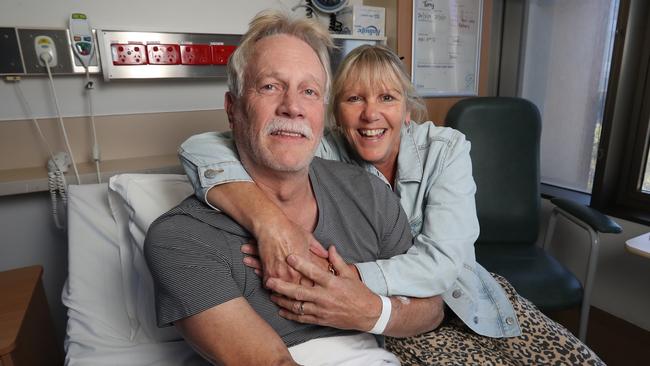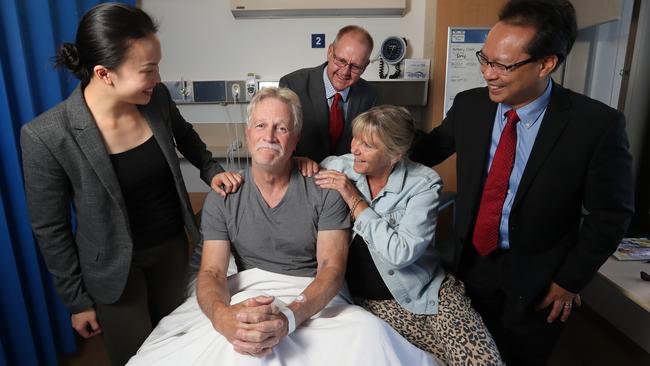Acute stroke survivors’ remarkable recoveries thanks to pioneering treatment developed in Melbourne
Two Melbourne acute stroke victims are making dramatic recoveries after becoming the first patients in the world to undergo an experimental treatment. This is what’s behind the medical breakthrough.

VIC News
Don't miss out on the headlines from VIC News. Followed categories will be added to My News.
Two Melbourne acute stroke victims are making dramatic recoveries after becoming the first patients in the world to undergo an experimental stem cell treatment.
Their cases have fuelled hopes among a Melbourne medical team pioneering the use of stem cells infusions as a potential therapy to reduce brain injury and improve recovery after a stroke.
The men’s treatment at Monash Medical Centre comes after more than a decade of promising research.
EXERCISE MAY HELP PROSTATE CANCER SIDE EFFECTS
WHY YOUR SMARTPHONE MAY BE BAD FOR YOUR HEALTH
VICTORIA’S PUBLIC SERVICE ‘HIGHLY STRESSED
But further cases are needed under an ongoing medical trial to determine firstly if the infusions are safe, and then how effective they are.
The first patient treated last month is back up and walking at home, while the second, 65-year-old Tony Clark was walking, talking and thanking his heroes days after having a stroke last Sunday.

About 6pm on Sunday, March 24, Mr Clark was with his wife Jackie at their Lysterfield home when his speech suddenly changed and he collapsed.
He was unable to speak the following morning and struggled to move, before being offered the chance to become the world’s second acute stroke patient to receive a stem cell infusion.
Believing he had nothing to lose, he received a 250ml infusion full of hundreds of millions of stem cells 20 hours after his stroke.
“I have to learn to speak again, but the rest … I can feel things coming back,” Mr Clark said.
He said the researchers were “amazing, amazing. They really are.”
While it is too early to judge the impact of the stem cells, Assoc Prof Henry Ma said the joint La Trobe University, Hudson Institute, Monash University and Monash Medical Centre research was “extremely encouraging”.
“We potentially, in the future, have a treatment that reduces deficit right from the start,” Assoc Prof Ma said.
“At the start he (the first patient) was having a droopy face, speech problems and arm weakness. But by the time I saw him all he had was a tiny droop on the face, everything else was back to normal.
“Obviously we can’t say it was the stem cells, but this is a very rapid improvement compared to what we usually see.
“I always tell my patients we are not talking about days, we are talking about weeks and months — but this guy did it in days.”
The therapy involves using an intravenous drip to infuse patients with hundreds of millions of amniotic stems cells within the first 24 hours after they suffer a stroke.
Previous animal studies led by Latrobe’s Prof Chris Sobey showed the therapy was neuroprotective and able to reduce brain injury and inflammation, lessening short-and long-term deficits.
The stem cells are collected from donated placentas immediately after childbirth and stored frozen until needed. Unlike other sources of stem cells, those collected from the placenta can be given to any patient without having to be matched or with the fear of rejection.
As well as the groundbreaking stroke study, the Hudson’s Assoc Professor Rebecca Lim is also leading trials using the stem cells to repair the lungs of premature baby lungs, benefit liver cirrhosis patients and will soon begin clinical trial to treat Crohn's disease.

DUSTY: ‘DAD, I NEED TO GET HELP’
REGIONAL VICTORIANS CLOSER TO BREAKTHROUGH MEDICAL TRIALS
“The safety outcomes have been consistent and it is very encouraging to continually see these positive responses, albeit in very early phases of safety testing,” Assoc Prof Lim said.
Under the Phase 1 stroke trial a further 13 acute stroke patients will undergo the treatment over the next two years to determine if it is safe and gauge the most suitable dosage.
While the first two patients have been successfully infused with 200 million stem cells for every 1kg of their weight — about the number collected from a single placenta — later patients will be infused with up to 32 million cells.
If the safety trial is successful a larger Phase 2 study will follow.
As one of the country’s biggest killers and leading causes of disability in adults, an Australian suffers a stroke every nine minutes.
Having seen promising results in his first two patients to undergo the stem cell therapy, Monash Health’s Prof Thanh Phan is hopeful it could become a cost-effective future treatment that can even be administered by paramedics responding to suspected strokes.
“Our first patient has had his one month visit — he walked back to the clinic, so he is doing very well and is happy,” he said.
Originally published as Acute stroke survivors’ remarkable recoveries thanks to pioneering treatment developed in Melbourne


